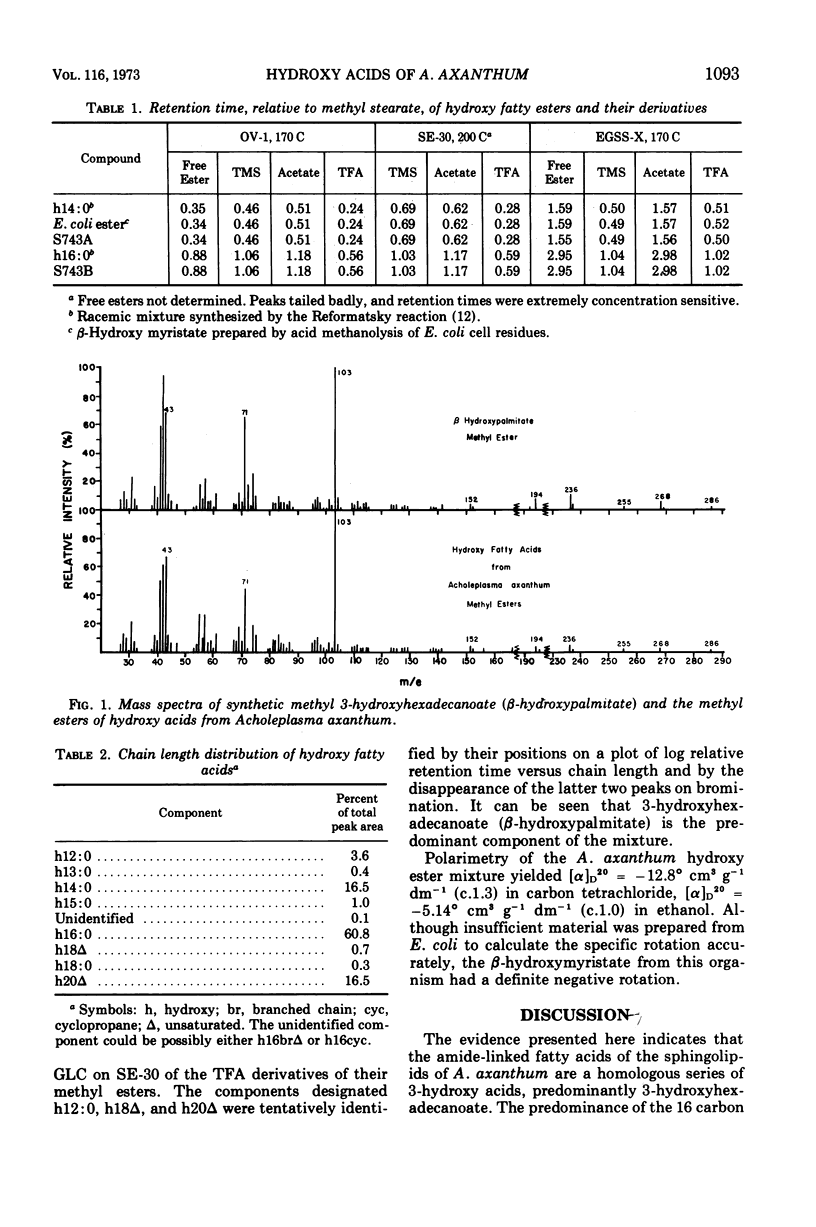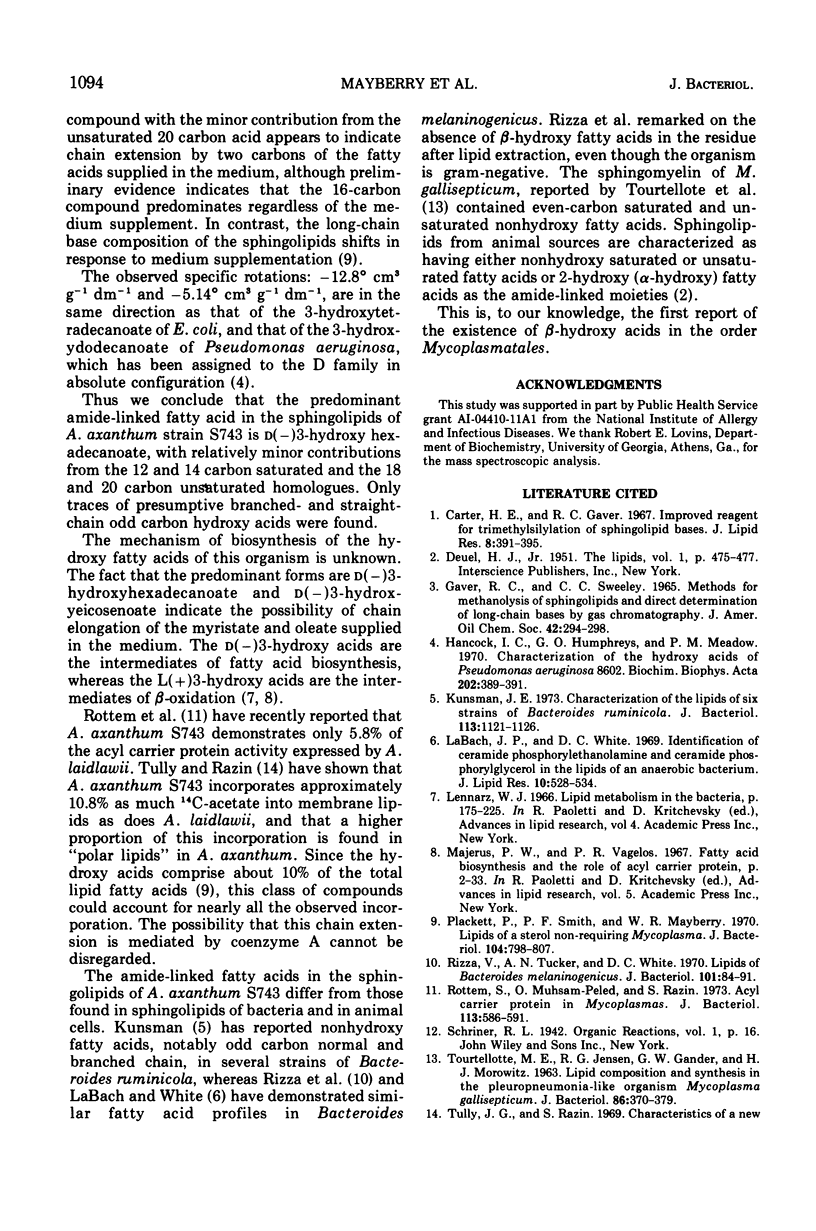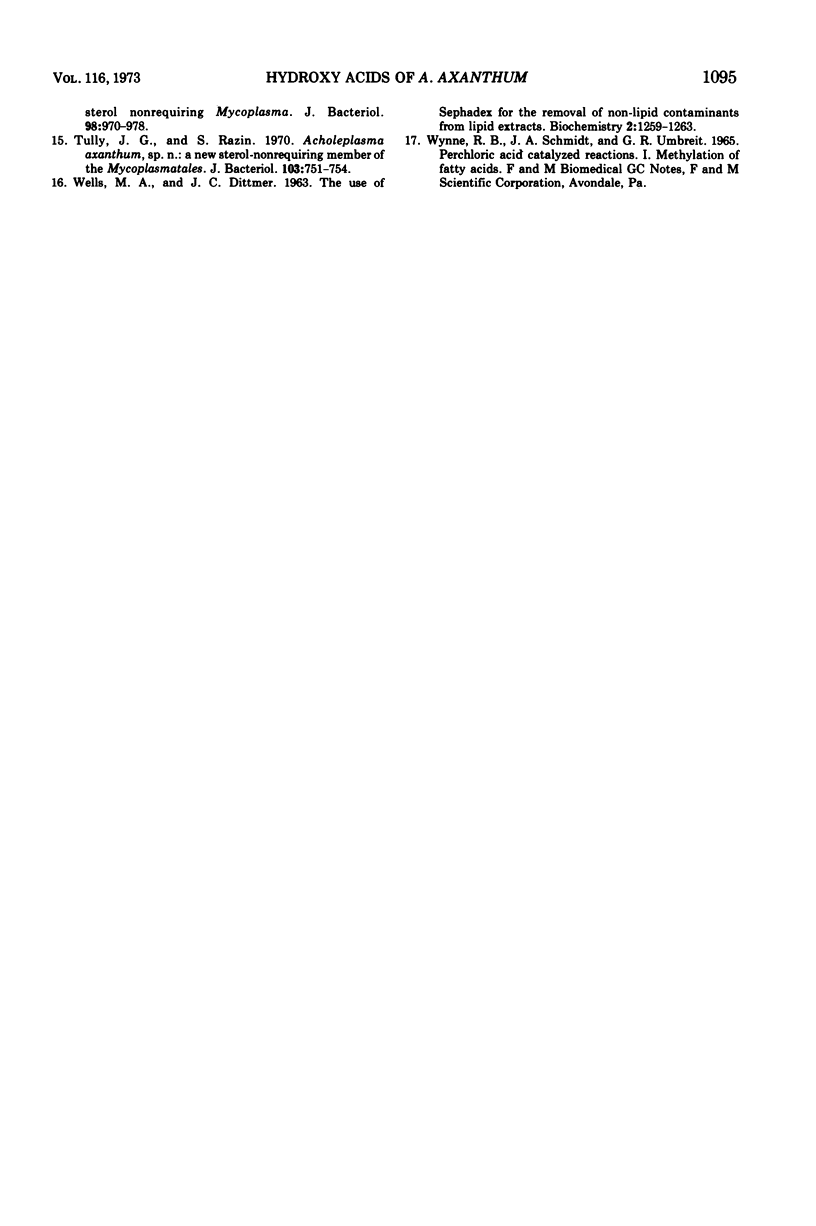Abstract
The amide-linked fatty acids of the sphingolipids of Acholeplasma axanthum S743 are predominantly hydroxy acids. These acids were shown by gas-liquid chromatography, mass spectrometry, and polarimetry to be the d(–)3-hydroxy fatty acids. The predominant component of the mixture was 3-hydroxyhexadecanoate (β-hydroxypalmitate, hydroxy [h] 16:0) followed by h 20Δ (Δ = unsaturated), h14:0, h12:0, and h18Δ in decreasing order of concentration. The fatty acid profile indicates that these β-hydroxy acids possibly arise from elongation of the fatty acids supplied in the growth medium.
Full text
PDF




Selected References
These references are in PubMed. This may not be the complete list of references from this article.
- Carter H. E., Gaver R. C. Improved reagent for trimethylsilylation of sphingolipid bases. J Lipid Res. 1967 Jul;8(4):391–395. [PubMed] [Google Scholar]
- GAVER R. C., SWEELEY C. C. METHODS FOR METHANOLYSIS OF SPHINGOLIPIDS AND DIRECT DETERMINATION OF LONG-CHAIN BASES BY GAS CHROMATOGRAPHY. J Am Oil Chem Soc. 1965 Apr;42:294–298. doi: 10.1007/BF02540132. [DOI] [PubMed] [Google Scholar]
- Hancock I. C., Humphreys G. O., Meadow P. M. Characterisation of the hydroxy acids of Pseudomonas aeruginosa 8602. Biochim Biophys Acta. 1970 Mar 10;202(2):389–391. doi: 10.1016/0005-2760(70)90204-3. [DOI] [PubMed] [Google Scholar]
- Kunsman J. E. Characterization of the lipids of six strains of Bacteroides ruminicola. J Bacteriol. 1973 Mar;113(3):1121–1126. doi: 10.1128/jb.113.3.1121-1126.1973. [DOI] [PMC free article] [PubMed] [Google Scholar]
- LaBach J. P., White D. C. Identification of ceramide phosphorylethanolamine and ceramide phosphorylglycerol in the lipids of an anaerobic bacterium. J Lipid Res. 1969 Sep;10(5):528–534. [PubMed] [Google Scholar]
- Lennarz W. J. Lipid metabolism in the bacteria. Adv Lipid Res. 1966;4:175–225. doi: 10.1016/b978-1-4831-9940-5.50012-0. [DOI] [PubMed] [Google Scholar]
- Plackett P., Smith P. F., Mayberry W. R. Lipids of a sterol-nonrequiring Mycoplasma. J Bacteriol. 1970 Nov;104(2):798–807. doi: 10.1128/jb.104.2.798-807.1970. [DOI] [PMC free article] [PubMed] [Google Scholar]
- Rizza V., Tucker A. N., White D. C. Lipids of Bacteroides melaninogenicus. J Bacteriol. 1970 Jan;101(1):84–91. doi: 10.1128/jb.101.1.84-91.1970. [DOI] [PMC free article] [PubMed] [Google Scholar]
- Rottem S., Muhsam-Peled O., Razin S. Acyl carrier protein in mycoplasmas. J Bacteriol. 1973 Feb;113(2):586–591. doi: 10.1128/jb.113.2.586-591.1973. [DOI] [PMC free article] [PubMed] [Google Scholar]
- TOURTELLOTTE M. E., JENSEN R. G., GANDER G. W., MOROWITZ H. J. LIPID COMPOSITION AND SYNTHESIS IN THE PLEUROPNEUMONIA-LIKE ORGANISM MYCOPLASMA GALLISEPTICUM. J Bacteriol. 1963 Sep;86:370–379. doi: 10.1128/jb.86.3.370-379.1963. [DOI] [PMC free article] [PubMed] [Google Scholar]
- Tully J. G., Razin S. Acholeplasma axanthum, sp. n.: a new sterol-nonrequiring member of the Mycoplasmatales. J Bacteriol. 1970 Sep;103(3):751–754. doi: 10.1128/jb.103.3.751-754.1970. [DOI] [PMC free article] [PubMed] [Google Scholar]
- WELLS M. A., DITTMER J. C. THE USE OF SEPHADEX FOR THE REMOVAL OF NONLIPID CONTAMINANTS FROM LIPID EXTRACTS. Biochemistry. 1963 Nov-Dec;2:1259–1263. doi: 10.1021/bi00906a015. [DOI] [PubMed] [Google Scholar]


